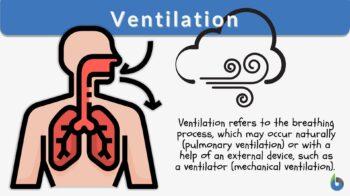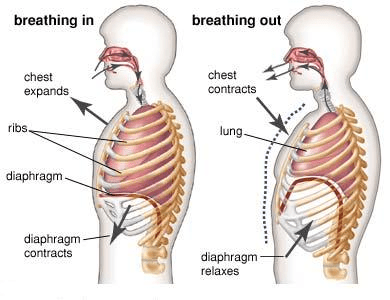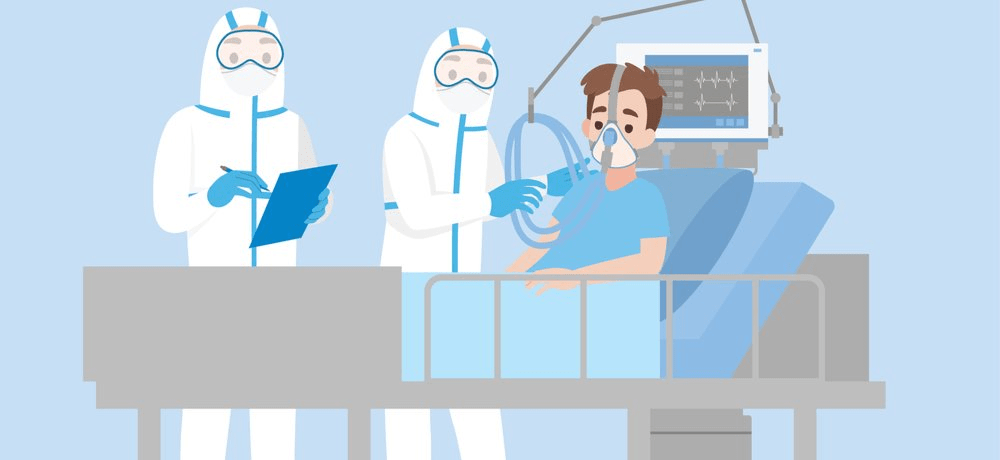
Ventilation
n., [ˌvɛntɪˈleɪʃ(ə)n]
Definition: breathing process or the provision of air for gas exchange
Table of Contents
Ventilation Definition
Often when persons think of ventilation, they think of getting clean or enough air into a room. This is how the average person would define ventilation. However, what is ventilation in the body? In science, ventilation is the process of the lungs obtaining air by exchanging the contents with the environment. This is the pulmonary ventilation definition and the most common type of ventilation in land animals. This process is what allows us to physically breathe. The ventilation medical definition, in turn, refers to the breathing process by the respiratory system, such as that of the human body.
When we think of the ventilation definition in anatomy, we think of the structures and organs involved in this biological process. Ventilation usually involves the respiratory system, which included the nose, mouth, lungs, diaphragm, and respiratory passages, such as the bronchus and bronchioles. The ventilation definition in physiology refers to the functional process or the mechanism of ventilation. This is the movement of air in the atmosphere into and out of the lungs in an organism’s body. This process occurs smoothly because of the pressure gradients between the lungs and the atmosphere.

Ventilation refers to the breathing process of a living thing. For example, in humans, pulmonary ventilation is a type of ventilation that takes place between the lungs and the environment. Two main types are pulmonary ventilation and mechanical ventilation. In general, a person at rest typically breathes and exhales air, at a rate of five to six liters per minute.
Types of Ventilation
The two main types of ventilation are pulmonary ventilation and mechanical ventilation. These deal with the natural ventilation that occurs when an organism functions as usual or with assisted ventilation when an organism needs help with the process of ventilation.
1. Pulmonary ventilation
Normally known as breathing, pulmonary respiration is known as the process of gas exchange between the lungs and the atmosphere. Throughout this process, the air is continuously inhaled (taken into) and exhaled (released from) the lungs. The pressure differences in the lungs versus the atmosphere allow air to easily flow in and out. This is because like all gases, air flows from areas of high pressure to areas of low pressure.
The constant change in pressure is caused by the breathing movements as well as the recoil of elastic tissues. Together, these processes result in pulmonary ventilation. There are three pressures that help pulmonary ventilation to occur. The pressure that is present within the pleural cavity of the body is called intrapleural pressure. The pressure of the air outside of the body is atmospheric pressure. The pressure within the alveoli of the lungs is called interalveolar pressure. The intrapleural, atmospheric, and interalveolar (intrapulmonary) pressures are the three types of pressures that are involved in pulmonary ventilation.
The process by which air is taken into the lungs is known as inhalation or inspiration. Inspiration brings air into the lungs and allows gas exchange to occur. It occurs when the muscles of the respiratory system contract, which occurs in the active phase of ventilation. When the diaphragm contracts and the volume in the thoracic cavity increases, inspiration takes place. In order for this to occur, it must also simultaneously decrease the pressure in the alveoli so that air can flow smoothly into the lungs.
The process by which air is let out of the lungs is called exhalation or expiration. This is what completes the breathing cycle and releases air from the lungs. The diaphragm relaxes and the tissue elastic recoils, causing a decrease in the thoracic volume and an increase in intralveolar pressure during expiration.
2. Mechanical ventilation
Sometimes people need assistance with ventilation. This ventilation refers to the process by which the gas exchange between the lungs and the air occurs through the assistance of an external device that is connected to the patient. This is the medical definition of mechanical ventilation. This can occur when a patient is put into a medically induced coma or if they are having serious respiratory issues. This form of ventilation helps the patient to breathe, some even considering that the machine “breathes for” the patient.
The purpose of mechanical ventilation is to continue the gas exchange between the lungs and the air in order for the patient to be able to obtain oxygen. It is also there to reduce the effort the patient’s body may have to make to respire. This could be for numerous reasons that all amount to extra stress on the patient’s body. It can also help with anesthesia and muscle relaxation as well as help with lung expansion and stabilization of the thoracic wall. A mechanical ventilator can be seen in Figure 2 below.
The external device present in mechanical ventilation is called a ventilator. There are different types of ventilators and they all serve different purposes. High-frequency ventilators use a high-frequency mechanism to provide intermittent positive pressure, classifying them as oscillatory high-frequency and high-frequency jet ventilators. Continuous flow ventilators are needed for either intermittent flow or a constant, basic flow. Positive-pressure ventilators are used for pressure cycling and flow cycling or a mixture of the two.

Similarities and differences
Mechanical and pulmonary or natural ventilation have many similarities and differences. For instance, the purpose of both types of ventilations is to allow gas exchange to occur. Both also rely on the natural respiratory system in order for inspiration and expiration to occur. Mechanical and natural respiration also both rely on the recoil of the elastic in the lungs to change the pressure of the alveoli and force air out of the lungs. However, with mechanical ventilation, the gas exchange is facilitated with the ventilator and isolated entirely from the air in the atmosphere. Whereas the gas exchange in pulmonary ventilation occurs solely and directly between the lungs and the atmosphere. Mechanical ventilation has a set rate at which it occurs because the ventilator must be set up to work at a certain speed. On the other hand, natural ventilation occurs based on the organism’s environment and will speed up in certain conditions as well as a slow down in others.
Try to answer the quiz below to check what you have learned so far about ventilation.
References
- Lei, Y. (n.d.). Lung Ventilation: Natural and Mechanical. In Medical Ventilator System Basics: A clinical guide. Oxford University Press. Retrieved February 27, 2022, from https://oxfordmedicine.com/view/10.1093/med/9780198784975.001.0001/med-9780198784975-chapter-3
- Mechanics of Ventilation | SEER Training. (n.d.). Retrieved February 27, 2022, from https://training.seer.cancer.gov/anatomy/respiratory/mechanics.html
- Muñoz Bonet, J. I. (2003). [Definitions in mechanical ventilation]. Anales De Pediatria (Barcelona, Spain: 2003), 59(1), 60–66. https://doi.org/10.1016/s1695-4033(03)78150-8
- Murias, G., Blanch, L., & Lucangelo, U. (2014). The Physiology of Ventilation. Respiratory Care, 59(11), 1795–1807. https://doi.org/10.4187/respcare.03377
- Powers, K. A., & Dhamoon, A. S. (2022). Physiology, Pulmonary Ventilation and Perfusion. In StatPearls. StatPearls Publishing. http://www.ncbi.nlm.nih.gov/books/NBK539907/
- Ventilation | BioNinja. (n.d.). Retrieved February 27, 2022, from https://ib.bioninja.com.au/standard-level/topic-6-human-physiology/64-gas-exchange/ventilation.html
- What is the difference between ventilation and respiration? (n.d.). Retrieved February 28, 2022, from https://www.ems1.com/ems-products/capnography/articles/back-to-the-basics-ventilation-vs-respiration-lzxEZ51j01JybDcq/
©BiologyOnline.com. Content provided and moderated by Biology Online Editors.




